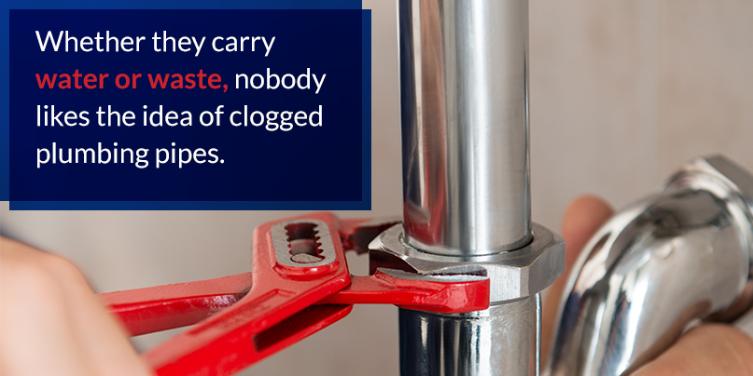
Table of Contents
- Common Causes
- Know the Main Components and How They Work Together
- Signs of a Possible Clog
- Preventative Measures: What You Can Do
- DIY Things to Try
Whether they carry water or waste, nobody likes the idea of clogged plumbing pipes. If plumbing water encounters a full or partial obstruction, that water will redirect itself and cause reactions that may include anything from backups and flooding to slow drainage and low pressure.
Some issues may cause minor headaches and hassle, while others inflict major damage and expense. Many people want to know how to prevent all types of clogged plumbing situations, or they seek solutions to some type of existing problem. More knowledge about the causes of clogged drains is the best insurance against mishaps and is always a great preventative measure to take against harmful blockage. What you know can then help to both avoid and identify problems.
It seems like it should be a fairly simple task to find a drain clog and remove it, but fixing clogged pipes can be complex and involved, depending on where the clog is located, what it consists of, and what must be done to access and remove it.
Common Causes
Sewer and water drainage systems in a house are configured a little bit like a tree and its branches. There’s a main line that’s usually the biggest in diameter, and sublines run off it that are typically a bit smaller in size. While the toilet is probably the most common place where clogs originate, they can start, build and disrupt function in and from any location in the system.
A blockage can build and lodge itself anywhere, but analysis will help narrow down the possibilities. You’ll be able to see what’s happening and what exactly the problem affects. If some part of the water or sewer main is clogged, the issue likely affects the whole household or building. If something is stuck in one of the sublines, whatever is happening will more than likely be isolated to one area or section of the building.
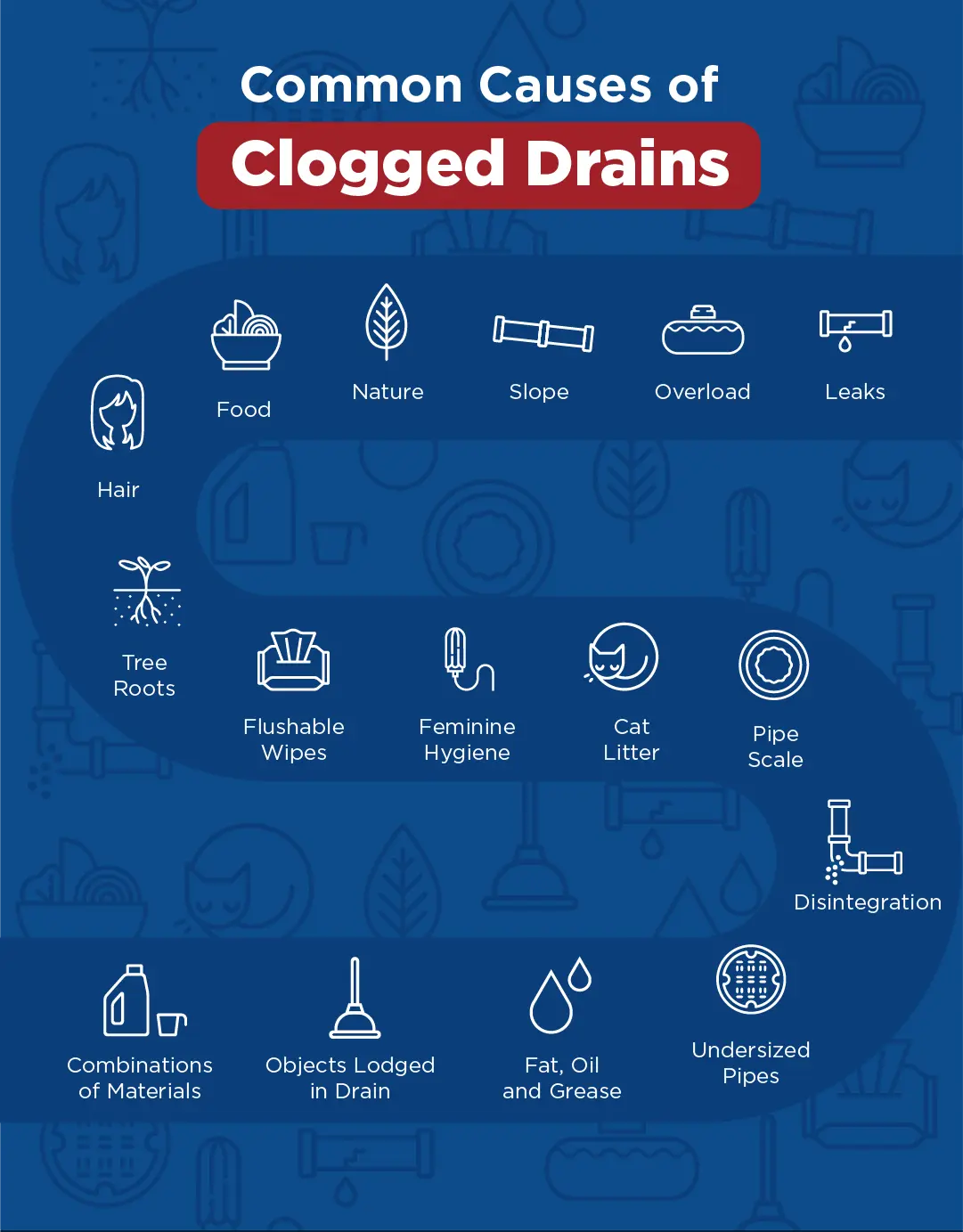
Here are the most common causes of blocked drains:

Tree roots
Tree roots are widely recognized as the number one cause of blockage and clogs in water and sewer mains. While it’s more common to find tree roots invading the pipes of older homes, the roots can find their way into systems of any age. Some experts say the first sign of tree root invasion into the sewer or water line is a gurgling sound.
As living things, the tree roots seek moisture and are more or less naturally drawn to the water in waste and sanitary sewer pipes, especially if one has a crack or springs or some other kind of leak.
If you live in a wooded area, or where there are many trees nearby, it’s important to be on the lookout for any tree root invasion. Some people decide to have a video inspection done every few years since the cost of the service is dramatically lower than addressing a neglected issue.
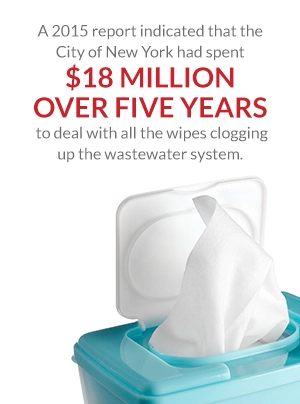
“Flushable” wipes
Flushable wipes can be a detriment to the system. Some cities and other entities responsible for wastewater processing and management have begun to discourage people from using the supposedly flushable wipes. A 2015 report indicated that the City of New York had spent $18 million over five years to deal with all the wipes clogging up the wastewater system.
These moist bathroom wipes, which have grown popular in recent years, have also prompted lawsuits over claims that the products disintegrate after they’re flushed. Allegedly, they don’t break up when flushed and are only called “flushable” due to their ability to physically fit into the pipe.
From small cities to the Federal Trade Commission, wipes and their impact on public systems have become a big deal — so much so that millions of dollars are said to be at stake, and public education campaigns are active in multiple states and cities. Some water treatment entities have dealt with the problem by buying expensive industrial shredders to process the wipes.
The truth about thick toilet paper, paper towels, facial tissue, light cardboard, and other paper products is that they’re not made to be flushed down the toilet. Home and commercial plumbing systems have the capacity to accept and process water, human waste, and biodegradable toilet paper. That’s it.
Feminine hygiene
Feminine hygiene products and baby diapers pose a danger to plumbing pipes because they do not biodegrade and contain cotton and other fibers that have a tremendous capacity to clog and attract other clogging agents. Neither are biodegradable, and both pose a threat to public and private systems alike.
The sewer treatment contains microorganisms that break down the human waste, but they do not disintegrate anything but that — even when pad wrappers and tampon applicators may claim to be “flushable.”
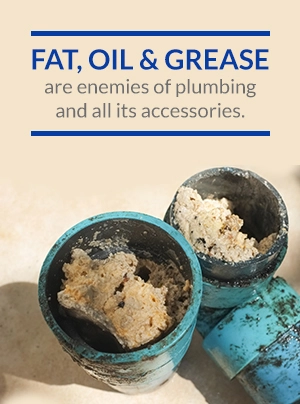
Fat, oil, and grease
Fat, oil, and grease are enemies of plumbing and all its accessories. Another increasingly publicized movement is one to educate consumers about the benefits of keeping oily substances from going down the drain, where they can build up and cause clogs. Employees in a commercial establishment must have specialized training on what does and does not belong in the drain and public system, but people in many private places could benefit from the same knowledge.
We like to think that most of us know better than to pour a pan of bacon grease down the drain or garbage disposal, but we may not think of some of the other things that contain fat, oil, or grease. For example trimmings from a steak or other meat, butter, vegetable oil, chocolate, cream, and more.
It’s easy to think that water just washes everything along, but fats are sticky, binding substances that are prone to causing buildups and eventually clogs. The trash can is a far better place to dispose of fat, oil, or grease. Bacon grease and many other fats and oils can be left to cool and will solidify or congeal for easy cleanup. Another preferred practice is to pour the oil or grease into a disposable container and then toss it in the trash.

Hair
Hair can accumulate to the point where it creates slow flow or total blockage. We can’t help that hair comes out of our heads naturally, but we can try to protect the drain as much as possible with small screens and good practices, such as sweeping the hair out of sinks and cleaning the hair brushes over the trash can.
When you see hair accumulate on the drain, or maybe hanging from it, use needle-nose pliers or work carefully with long tweezers to pull the hair out regularly, as opposed to letting it sit or wash down the drain. There are also a number of drain screens available that keep hair from going down the drain and make removal easier.
Pipe scale
Pipe scale is a product of nature that interacts with your pipes and can actually build to the point where you have a clog or blockage from the mineral deposits water leaves behind. Scale deposits usually result from dissolved calcium and magnesium and sometimes other metallic elements that are left behind as water flows.
These particles react to temperature as well as constant wet-dry conditions. The scale begins to collect in one spot, which attracts more scale until it grows to an obstructive size. Not only does mineral scale build up inside pipes, but it can also affect other water-using appliances, such as clothes and dishwashers.
Food
Food bits and chunks should be placed in the garbage — never in the sink, bathtub, or laundry drains. It especially should not be flushed down the toilet. None of these drains tolerate much of it, because that isn’t what they were designed to carry. Edibles can be sticky, stringy, sharp, or hard, none of which will be good in a water pipe.
While we’ll discuss garbage disposals in greater detail a bit later, know that certain foods are wholly incompatible with even powerful garbage disposal systems. The key to disposals is that they cut the material into tiny pieces that will travel through the drainage pipe without accumulation. Unfortunately, many of the foods we eat aren’t easily shredded.
Disintegration
The disintegration of the pipes can happen, especially with older homes or homes that may have aging concrete, clay, or terra cotta pipes. Joints can come apart and drop and soil can erode away, which allows the pipe to sag.
Where it freezes hard in the winter, there exists the possibility that pipes can shift under the continuous pressure and heave of the freeze-thaw process. Even with modern pipes that are usually made of super-hardened plastic, the damage is possible simply from natural soil shifts and seasonal changes.

Nature
Nature sometimes works its way into sewer or water lines, especially where pipes have separated. Leaves, sticks, dirt, rocks, and even rodents can create blockages underground that are difficult to detect. Leaves are pervasive and efficient clogging agents, so it’s generally a good practice to keep the yard clear of them and definitely not wash them down the storm sewer drain.
We’ve all seen a tiny weed sneak through the smallest of cracks, and any breach in the plumbing pipes is an opportunity for roots, plants, and soil to invade, build and end in blockage.
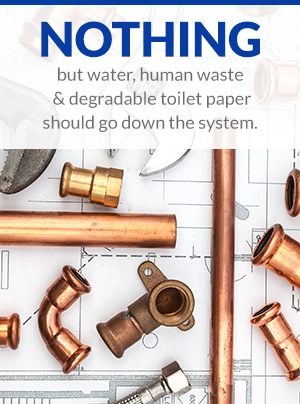
Objects
Objects such as bar soap can break off in chunks and become lodged in the drain, as well as other things that should not end up in there, such as jewelry, children’s toys, condoms, dental floss, and food. Again, nothing but water, human waste, and degradable toilet paper should go down the system.
The importance of that concept is proven by many articles and entire programs on “how to train” small, learning children and by numerous, humorous bathroom signs that remind adults to only deposit the basics.
Combinations
Combinations of materials can also team up and stick together to form a big, gooey ball of blockage that leads to strange sounds, slow drains, and, eventually, backups. Soaps and detergents can build up, attract other materials and create a clog, especially in septic system drain fields.
The recommendation from laundry experts is to use soaps that do not contain phosphates and which have natural (or no) surfactants, as opposed to ones developed from a petrochemical product. They also advise that those with a septic drain field pace the rate at which they wash clothes, instead of washing them one load after the other, so the system has time to work and doesn’t get overwhelmed.
Slope
The slope of the sewer and water pipes must be correct, or it will cause drainage problems and possibly blockage. Gravity drives most of the functions of water systems, so it’s crucial that the pipes have the correct slope to flow properly. The standard pitch of any drainage pipe should be at least 1/4 inch per foot, and sometimes more if some other characteristics of the terrain or household demand more slope to properly process the water and waste.
Undersized
Undersized sewer pipes can be the root cause of blockage and clogs. Unless you’ve been the sole owner of a property since its structures were newly built, it might be difficult or impossible to ascertain its complete plumbing history. Sometimes, people add onto a home or building without compensating for the added plumbing load, and there are plenty of instances where an unlicensed technician or inexperienced do-it-yourselfer miscalculated the system loads.

The size of sewer drain piping used in a home or other building is determined by the number of water-using units, such as toilets, sinks, and bathtubs, that discharge to it. A widely accepted minimum standard for the main drain of a home is four inches in diameter, but many plumbers and consumers will go with one bigger than that based on household needs and usage.
Overload
Overload is also possible, even when the sewer main is properly sized — particularly if the household is on a septic system and its waste capacity has grown. The drain field and other workings of a septic system can become overwhelmed and fail to drain, which usually produces bad smells and/or backups.
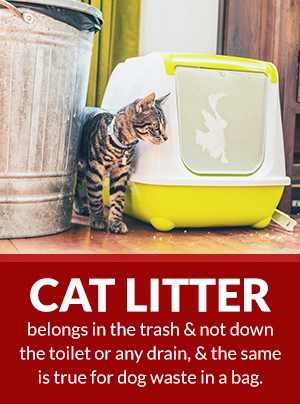 Leaks
Leaks
Leaks are an enemy of the sewer and main drains, because if water is leaking out underground, the soil will erode as well as become soaked, which will allow the pipe to drop, sag, or otherwise change position. The leaking water changes the chemical composition of the soils around it, so the pipe becomes displaced and may even break.
Cat litter
Cat litter belongs in the trash and not down the toilet or any drain, and the same is true for dog waste in a bag. All kitty litter is made of clay-based material that can actually harden like concrete when it’s been wet and dry enough times. The litter pieces are sharp and can easily catch on other things, which only increases the chances of a clog.
Know the Main Components and How They Work Together
Modern plumbing concerns the many interconnected systems within a home that we rely on for comfort, convenience, cleanliness, and, to a certain extent, safety. Here are the main components of your plumbing system: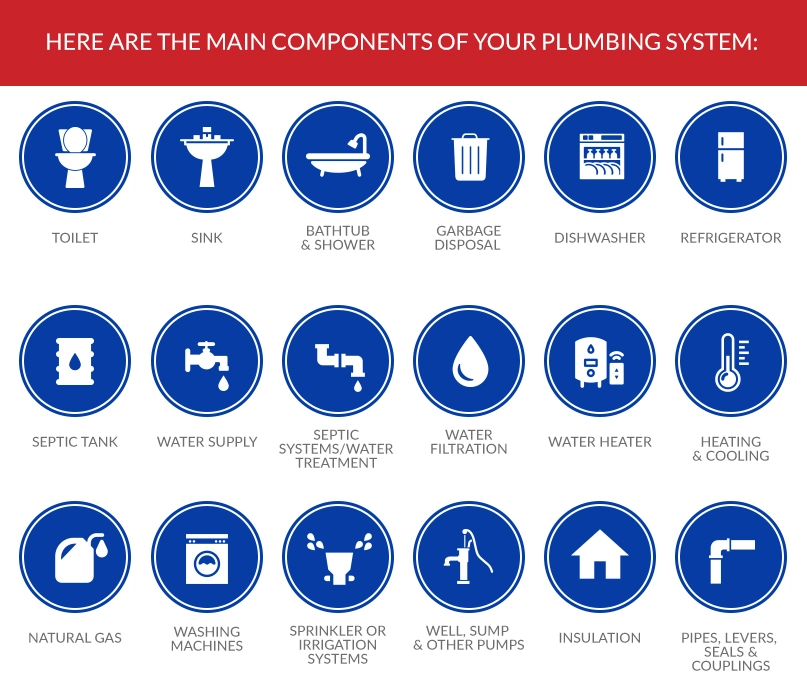
- Toilet
- Sink
- Bathtub and shower
- Garbage disposal
- Dishwasher
- Refrigerator
- Septic tank
- Water supply (both public and private wells)
- Septic systems/water treatment
- Water filtration
- Water heater
- Heating and cooling
- Natural gas
- Washing machines
- Sprinkler or irrigation systems
- Well, the sump and other pumps
- Insulation
- Pipes, levers, seals, and couplings
When any of these utilities cease to function, or don’t work as well as they should, this not only disrupts our comfort but may also cause enormous expenses if damage occurs. More good preventative actions we can take against clogs and their ensuing problems include keeping a watchful eye on all the systems and reacting quickly, rather than procrastinating or ignoring it, when one shows signs of trouble or substandard performance.
Inspections, regular maintenance, and a general awareness of overall operations will help keep your plumbing systems running smoothly. A professional, knowledgeable, service-minded plumbing partner such as Mr. Rooter Plumbing of Greater Syracuse can give assistance with repairs and maintenance, as well as overall plumbing system service plans.
There are two main types of drainage systems found in homes and buildings: those for water used by humans and those for water that falls as rain.
We tend to think of wastewater as only what we flush down the toilet, but it also includes the used water from our washing machines, sinks, showers, and other water-using utilities and appliances. That water gets drained from each area of the house or other building to a house or main drain, which then routes it to either a private septic system or to a public wastewater treatment plant.
Water that falls as rain in urban areas usually runs into a storm sewer system that’s eventually routed to a water body, such as a lake or river, or sometimes a retention pond designed to hold and filter the water. In both commercial and residential settings, there can be private utilities for outdoor drainage, such as a dry well or catch basin, to help route and naturally filter stormwater.
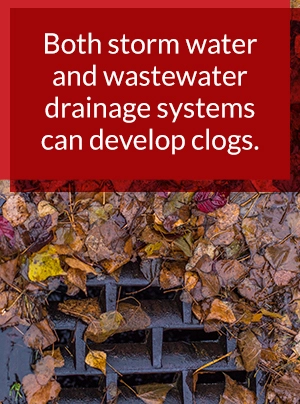
The stormwater and wastewater systems are typically separate, but there are conditions under which stormwater is also routed to a septic system or wastewater treatment facility. Since wastewater drainage pipes are buried beneath the frost line of an area, they’re required to have cleanout points every 50 feet. These usually consist of a capped piece of white pipe that visibly sticks out of the ground.
While most of us would agree that a sewage backup is probably the bigger nightmare, both stormwater and wastewater drainage systems can develop clogs and cause headaches.
Signs of a Possible Clog
Clogs can develop in any part of the plumbing system, including drain blockage outside or inside. Some clues are more obvious than others, partly because so much of the system exists under the ground or in the walls where we don’t see it.
For example, water spraying from a pipe joint or standing in the sink would be easy to spot, but it’s not as easy to determine why a drain has slowed over time or to discover the existence of an underground leak.
Particularly in the parts of the system that handle waste, our worst fear may be that water backs up and overflows from the toilet, septic, or sewer system. Clogged and blocked drainage systems most often cause this nightmare scenario, which would include possible damage to the sewage line, septic system or other components. The possibility of a mishap makes it even more practical to become savvy about drain blockage causes.
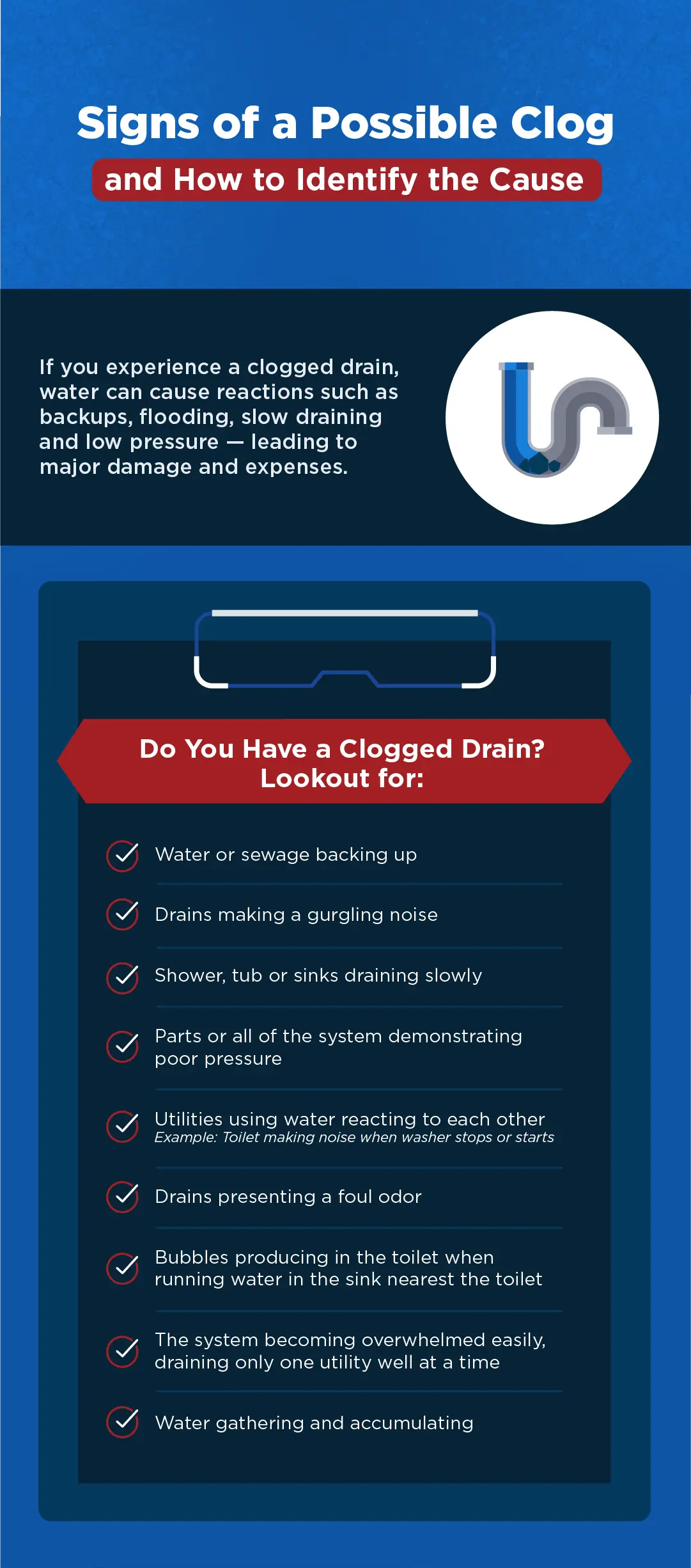
To get to the cause, you first have to realize and detect the problem. There are several signs that might indicate you have a clog, or that one may be developing.
1. When water or sewage backs up into a toilet, sink, bathtub, or anywhere inside or outside, especially in low spots, such as basement toilets and showers.
2. When the drain makes a gurgling noise as other plumbing functions take place. Under normal circumstances, when the water flows unimpeded through the pipe, it shouldn’t make a lot of noise other than maybe a smooth-flowing sound. However, when there’s a clog in the sewer or water pipe, water hits it and releases oxygen, causing bubbles that make noise and even release smelly gases.
3. When the shower, tub or sink drains slowly — for example, if your feet are submerged during the shower.
4. When there’s poor pressure in parts or all of the system, which could be noticeable in the sink or shower and probably produce a weak toilet flush.
5. If the utilities that use water react to each other, such as the toilet making noise when the washer stops or starts.
6. When there’s a foul odor present, it sometimes means there’s a wad of goop or something accumulating within the drain. As you can imagine, whatever is causing the blockage probably doesn’t have a pleasant smell.
7. When water backs up in drains as other utilities are used.
8. When you run water in the sink closest to the toilet for a few minutes and it produces bubbles in the toilet, this can indicate that the problem is in the sewer main and not the toilet itself.
9. If the system becomes overwhelmed easily — for example, when only one utility at a time can drain well.
10. When water gathers around the floor drain in a basement, or there’s saturated soil or pooling water in the yard.

Contact A Drain Cleaning Expert
Preventative Measures: What You Can Do
The list of things to do that may help reduce the chance of a clog or blockage could go on, but we’ve included some precautionary information that comes from a place of experience and is based on what plumbers see and treat in the commercial and residential service world.
- Camera inspection: One of the most unnerving things for homeowners is having some of the plumbing components underground and out of sight. Sewer and house main drains exist beneath the frost level, which, for the Syracuse area, is 42 inches. If a clog does develop, it may seem impossible to determine its location.
The subsurface cameras of today eliminate that concern since they can be placed into the system to see what we cannot, including the exact location and even composition of the troublesome clog or blockage.
In the way of maintenance, there’s no clearer picture than a subsurface video inspection to make sure no cracks or other breaches have developed in any of the pipes. A thorough video inspection can help prospective home buyers to know that elusive plumbing history or help someone find and retrieve a lost item of value. Cameras have all but replaced all the digging, ripping, and disruption of past clog-clearing and problem-finding techniques.
The accuracy of a video inspection eliminates guesswork and expense repairs since service or other attention can be directed to exactly where it’s needed. The camera can run through the entire system of pipes or look at a particular section. It can illuminate the area and pan around to show nearby conditions.
- Toilet tendencies: It can hardly be overemphasized that the only materials that belong in a toilet are water, waste, and biodegradable toilet paper. Still, things happen and stuff gets flushed, but a few things can help prevent foreign objects from getting flushed and potentially causing a clog or backup.
You might consider placing lid locks on your toilets to keep out toys and all the other imaginative things young children decide to flush.
It can also help to take precautions and place a lined trash can within arm’s reach of the toilet. This is a common feature in commercial settings, where customers expect to be able to change their children at a designated area and dispose of the refuse quickly and without fuss. Maintaining this standard in your bathroom will discourage anyone from being tempted to “just flush” a feminine hygiene product or baby diaper.
In addition, place a plunger beside each toilet so it’s never far away when needed. Of all the ways a plumbing system can react to a problem, a toilet overflow is among the least-desired situations. If something weird does go down, it may be better to call a plumber right away rather than to plunge, which could just drive the object farther down the line or lodge it even more tightly in the pipe.
If the object does manage to make it out of your pipes and into either the private or public system, it has the potential to cause damage that might have a high price tag.
- Water main awareness: The basic message here: Know where the water main is and how to shut it off, because it will be the most damage-saving step you can take if and when there’s a backup or something bursts under pressure.
It might be a lever or wheel-type handle attached to the main water line in the basement, garage, or utility closet, depending on how a home is configured. Each individual home has a shutoff valve within it and usually somewhere outside, too — especially those with a public water supply.
Many times, you can learn where the main is located just by looking around and doing some logical testing after you turn the lever or handle, and in some cases, it’s conveniently marked “main.” If you look but aren’t sure about the water main location, a plumber or the local utility professionals can show you where it is and how to turn it on and off.
Most of the water-using appliances in a home or building will also have an individual cutoff valve so each one can be turned off individually, including toilets and sinks.

- Provide pressure: Some experts say a well-kept secret of healthy plumbing is to fill each sink with water once or twice a month and let them drain to create pressure that flushes the pipes and removes debris. A full tub would have the same effect. To help fat, oil, and grease get off the sides of pipes and travel through the treatment system, it’s helpful to occasionally pour a pan of boiling water down the kitchen sink drains.
 Disposal defense: It can literally pay to know what not to put down the disposal. Many food items — even “natural” ones — are tough and fibrous and may not shred the way you expect them to when you toss them in the disposal. Avoid the following:
Disposal defense: It can literally pay to know what not to put down the disposal. Many food items — even “natural” ones — are tough and fibrous and may not shred the way you expect them to when you toss them in the disposal. Avoid the following:
- Celery
- Eggshells
- Meat, skin, and bones
- Tough fruit rinds, such as watermelon or cantaloupe
- Pumpkin
- Potato peels
Garbage disposals are nice to have, but some of us mistake them for trash cans that can pretty much take on anything. In reality, there’s a variety of things that the blades don’t chop well and are better going in a compost pile or the garbage.
Clogs can also result from simply too much material at once being fed into the disposal, since it’s best to feed them gradually and let water run before, during, and after the operation.
- Clean pipes: When it comes to drain cleaning, this term and suggested action may sound like an impossibility because it’s hard to think of the sewer pipes or drain as clean, but periodic cleaning ensures proper function. Sewer pipe and drain cleaning service can usually be found for about $150, depending on the area, plumber, and travel time involved.
There are several techniques used to clean pipes and clear clogs, including winding snakes, augers, steam, and water pressure.
You’ll also find many kinds of home remedies, both to clear clogs and to serve as a maintenance cleaning between professional cleanings (see DIY section toward the end). Various combinations of vinegar, lemon juice, and baking soda are recommended, and it doesn’t hurt to try any of these natural ingredients that have a bubbly, cleansing, chemical reaction when mixed together.
An important point to keep in mind is this: Multiple applications of chemical drain cleaner should be avoided because too much of the harsh ingredients too often will degrade the inside of pipes and drains.
- Compare appliances: Sometimes the behavior of water drainage can be telling, such as how toilets flush and sink drain when the clothes washer and other appliances are running. Does water back up anywhere when a major water-using appliance is draining its used water? This may indicate a clog or blockage.
- Relieve pressure: When the clog or blockage causes a backup of the main line, it’s possible to release some of the pressure on the system by removing the cap on the sewer cleanout pipe. If one exists, it will be in the yard — typically a white pipe sticking up outside not far from the building. This can also be a way to check and see if there’s a clog or blockage in the main. If you remove the cap and water flows out, that could mean the main is blocked.
- Snake or auger: There are tools you basically stick into the proper pipe and they work to loosen and clear the blockage or clog. There are other, similar tools used for the task, such as a kinetic water ram, but most have the goal of clearing the clog. A plumbing auger or snake is typically made of steel and has some kind of aggressive-grab tip.
An auger or a snake can be powered manually, electrically, or hydraulically. If you rent or borrow this tool, be sure it has enough power and feet of line to serve your needs.
- Analyze water quality and usage: Easy at-home tests can give you good data on the plumbing system. The first is to watch the water bill for increases that don’t measure up to usage. If the gallon number spikes with no explanation, it can indicate an underground leak and sprinkler lines are often where the problem is found.
It’s also easy to take some of your water for a test to one of several entities that can tell you exactly what it contains. Many people like the peace of mind once a year from knowing that the water quality has not changed — especially consumers who are looking to treat their water.
- Sooner is better: The best time to investigate any problems is right when you suspect you might be having the problem because procrastination does not pay when it comes to plumbing. If there’s slow drainage, low pressure, gurgling, or some of the other signs present in a system, it’s much better to pay for cleaning of the pipes than to pay for cleanup after toilet overflow or complete failure of the sewer main.

DIY Things to Try
Beyond having a solid, basic knowledge of the plumbing system, there are a few things to try when you suspect a clog:
- Check the visible parts of the drain for hair, scale, or foreign objects.
- Try pouring a panful of boiling water down the sinks.
- Pour a pitcher of water down a toilet that won’t flush.
- Use the recommended amount of drain cleaner, avoiding multiple applications of it.
- Use a plunger, taking care to use the correct plunger for the job, since a toilet plunger won’t work on a sink and vice-versa.
- Start by pouring one gallon of hot water followed by 1/2 cup of baking soda and then wait a few minutes before mixing one cup of vinegar with one cup of hot water and pouring that in last. This mixture is also good for occasional at-home pipe cleaning.
- If you suspect the clog is in the p-trap (that U-shaped piece of pipe under most sinks), turn the water off to the sink and place a bucket under the pipe before unscrewing the joints at either end of the U.
Keep the Professionals’ Number Handy
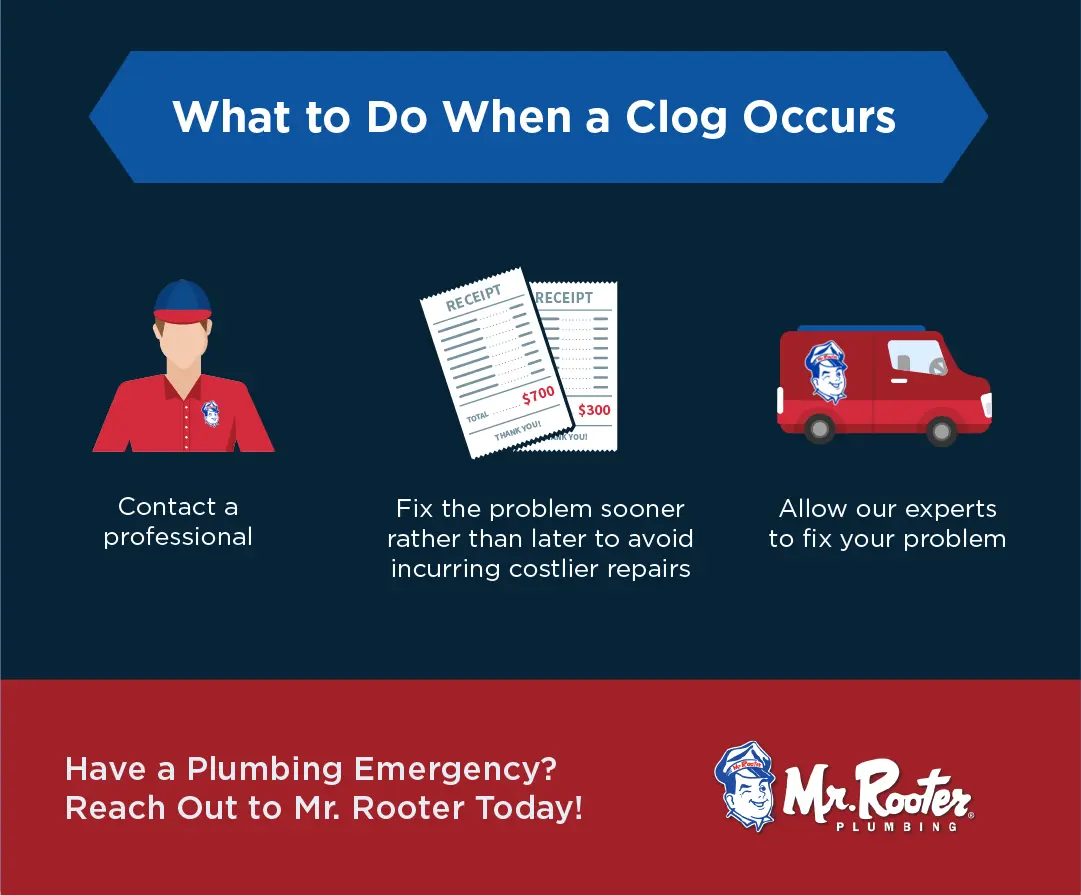
Mr. Rooter Plumbing provides the full range of expertise and skills needed to assess and remove any kind of clog or blockage, as well as repair any damage the problem might have caused to the plumbing system. Our specialists are professional, licensed plumbers who are also certified by Onondaga County for plumbing leak detection or any plumbing-related project in a residential or commercial setting. We’re familiar with the codes in the Syracuse-Oneida local area, as well as state and other applicable rules.
Whether you suspect there’s blockage or you already have an issue caused by a known clog, Mr. Rooter Plumbing can help resolve the issue. The best preventative measure, of course, is good maintenance practices, because they save you money over time by prolonging the life of your system and helping to prevent breakdowns and expensive repairs.
We make maintenance easy with a no-charge Plumbing Check Up, which consists of a professional visiting your house for an inspection. A general check of the system provides you with an assessment of its performance and will help to discover any issues or problems.
Almost always, it’s best to find and fix problems sooner rather than later since they can worsen over time and incur even costlier repairs. Mr. Rooter Plumbing offers answers to any of your plumbing questions and all of your plumbing service needs.

